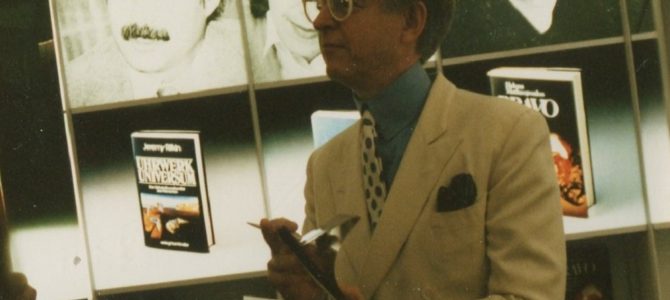Tom Wolfe died yesterday at age 88, after a long and colorful career as America’s carnival barker. I don’t mean that in a pejorative sense. The carnival barker has a certain reputation for brazen dishonesty in overselling his product. (We’ll get to that in a moment.) But he is also our enthusiastic guide to a raucous and colorful spectacle, and that seems like a perfect description of Wolfe’s work as he conceived it.
In some ways, Tom Wolfe was a writer I hated to love. His prose style was so extravagant and over-the-top that I once used him in writing classes as an example of what not to do. It wasn’t just that he sometime sacrificed intellectual clarity for the sake of a flamboyant sense of humor. It was the fact that he was so successful at it—even if you could criticize him, you couldn’t stop reading—that he tempted other writers to try to follow his example, with unfortunate results.
A Washington Post reporter captures the dilemma perfectly: “Warning to all editors currently posting their favorite Tom Wolfe newspaper excerpts: these will be used against you next time you tell me, ‘this paragraph is too overwritten for a newspaper.'” But the editors will probably tell her what I told my writing students: Wolfe could get away with it. You probably can’t.
Many of the retrospectives on Wolfe that you’ll see right now treat him as if he were remarkable only for his lively prose style and remarkable turns of phrase. Over the next few days, you will have the opportunity to hear many people’s favorite Wolfe lines—but not here, because I think they distract from his really unique and interesting contribution.
Wolfe was a pioneer in the 1960s of what was called the New Journalism. Rather than being an impersonal, seemingly impartial recounting of the facts, the New Journalism was written in a more literary, novelistic style. He did not tell you the facts about an event, a movement, a subculture. Wolfe immersed himself in that subculture, in the daily, telling details of its speech, dress, and mannerisms, and he made you feel as if you were immersed in it.
The New Journalism’s emphasis on subjective impression over objectivity, on the power of the narrative over the reporting of exact facts, has had a somewhat unhappy influence. That’s the carnival barker in the bad sense. But again, Wolfe could get away with it.
He could get away with it because he was a bottomless well of originality, and the reason was his enthusiasm about the endless variety of life in America—all of America. In an era when we’re concerned about cultural elites being caught in their own little bubbles, meeting nobody but people just like them who live just like them and think just like them, Wolfe set an example of endless curiosity about the world outside. In fiction and non-fiction, he sought to capture the subcultures of test pilots and astronauts, 1960s hippies, New York stockbrokers, surfers, real-estate developers, and on and on.
He compared America to a carnival—in a good way—and urged writers to “head out into this wild, bizarre, unpredictable, hog-stomping Baroque country of ours and reclaim its literary property.” In a famous essay, he described this approach as “Stalking the Billion-Footed Beast” and complained that publishers “had their noses pressed against their thermopane glass walls scanning the billion-footed city for the approach of the young novelists who, surely, would bring them the big novels of the racial clashes, the hippie movement, the New Left, the Wall Street boom, the sexual revolution, the war in Vietnam. But such creatures, it seemed, no longer existed. The strange fact of the matter was that young people with serious literary ambitions were no longer interested in the metropolis or any other big, rich slices of contemporary life.”
He complained that the prominent highbrow “literary” giants of the day wrote about the interior lives of people just like them, who lived in and passed through strangely generic towns and streets. They were cloistered in their own little world and ignored the great carnival of America.
This is the theme that also ran through his earlier critiques of Modernist art and architecture. In The Painted Word, he described the highbrow art establishment as a provincial small town, “Cultureburg,” where a population of a few thousand people decided what art the rest of us ought to like. In From Bauhaus to Our House, he derided the artistic compounds in which theorists wrote manifestos and drew designs meant to communicate with and for each other. Our new era of politically didactic art would not be any kind of surprise to him.
If he was endlessly curious about the world outside New York’s highbrow cultural circles, he was also curious about what went on inside it—curious enough to probe its peculiarities and expose is hypocrisies and perversities. “Radical Chic”—the title of his 1970 essay recounting an elegant society dinner party thrown by Leonard Bernstein for the Black Panthers—has become a universally recognized shorthand for the superficial revolutionary posturing of wealthy leftists. He paired it with “Mau-Mauing the Flak Catchers,” which portrayed Great Society welfare programs as a kind of racial Kabuki Theater that exists, not to help the poor, but to make a show of appeasing their anger.
These essays, and many more, displayed an independence from the political and artistic mainstream that made Wolfe indispensible. This is something we’re beginning to lose: the kind of independent, iconoclastic intellectual who was not beholden to any particular orthodoxy, but who was so interesting to read that nobody cared.
He was Tom Wolfe. He could get away with it.
Robert Tracinski is a senior writer for The Federalist. His work can also be found at The Tracinski Letter.









